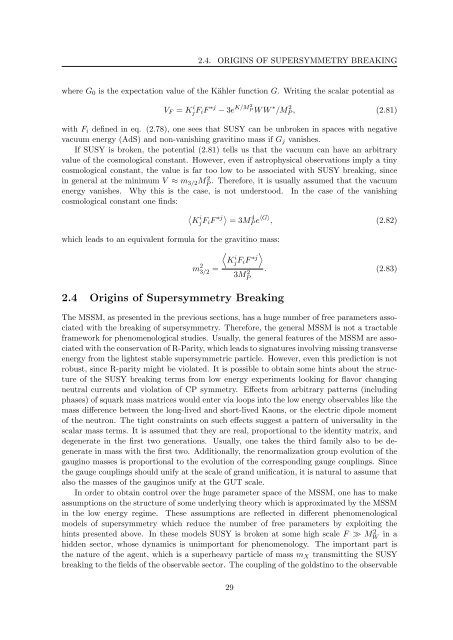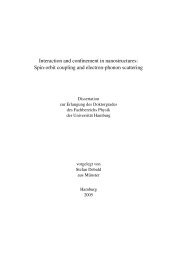Gravitinos and hidden Supersymmetry at the LHC - Universität ...
Gravitinos and hidden Supersymmetry at the LHC - Universität ...
Gravitinos and hidden Supersymmetry at the LHC - Universität ...
Create successful ePaper yourself
Turn your PDF publications into a flip-book with our unique Google optimized e-Paper software.
2.4. ORIGINS OF SUPERSYMMETRY BREAKING<br />
where G 0 is <strong>the</strong> expect<strong>at</strong>ion value of <strong>the</strong> Kähler function G. Writing <strong>the</strong> scalar potential as<br />
V F = K i jF i F ∗j − 3e K/M 2 P W W ∗ /M 2 P , (2.81)<br />
with F i defined in eq. (2.78), one sees th<strong>at</strong> SUSY can be unbroken in spaces with neg<strong>at</strong>ive<br />
vacuum energy (AdS) <strong>and</strong> non-vanishing gravitino mass if G j vanishes.<br />
If SUSY is broken, <strong>the</strong> potential (2.81) tells us th<strong>at</strong> <strong>the</strong> vacuum can have an arbitrary<br />
value of <strong>the</strong> cosmological constant. However, even if astrophysical observ<strong>at</strong>ions imply a tiny<br />
cosmological constant, <strong>the</strong> value is far too low to be associ<strong>at</strong>ed with SUSY breaking, since<br />
in general <strong>at</strong> <strong>the</strong> minimum V ≈ m 3/2 MP 2 . Therefore, it is usually assumed th<strong>at</strong> <strong>the</strong> vacuum<br />
energy vanishes. Why this is <strong>the</strong> case, is not understood. In <strong>the</strong> case of <strong>the</strong> vanishing<br />
cosmological constant one finds:<br />
〈<br />
K<br />
i<br />
j F i F ∗j〉 = 3M 4 P e 〈G〉 , (2.82)<br />
which leads to an equivalent formula for <strong>the</strong> gravitino mass:<br />
〈 〉<br />
K i<br />
m 2 3/2 = j F iF ∗j<br />
3M 2 P<br />
2.4 Origins of <strong>Supersymmetry</strong> Breaking<br />
. (2.83)<br />
The MSSM, as presented in <strong>the</strong> previous sections, has a huge number of free parameters associ<strong>at</strong>ed<br />
with <strong>the</strong> breaking of supersymmetry. Therefore, <strong>the</strong> general MSSM is not a tractable<br />
framework for phenomenological studies. Usually, <strong>the</strong> general fe<strong>at</strong>ures of <strong>the</strong> MSSM are associ<strong>at</strong>ed<br />
with <strong>the</strong> conserv<strong>at</strong>ion of R-Parity, which leads to sign<strong>at</strong>ures involving missing transverse<br />
energy from <strong>the</strong> lightest stable supersymmetric particle. However, even this prediction is not<br />
robust, since R-parity might be viol<strong>at</strong>ed. It is possible to obtain some hints about <strong>the</strong> structure<br />
of <strong>the</strong> SUSY breaking terms from low energy experiments looking for flavor changing<br />
neutral currents <strong>and</strong> viol<strong>at</strong>ion of CP symmetry. Effects from arbitrary p<strong>at</strong>terns (including<br />
phases) of squark mass m<strong>at</strong>rices would enter via loops into <strong>the</strong> low energy observables like <strong>the</strong><br />
mass difference between <strong>the</strong> long-lived <strong>and</strong> short-lived Kaons, or <strong>the</strong> electric dipole moment<br />
of <strong>the</strong> neutron. The tight constraints on such effects suggest a p<strong>at</strong>tern of universality in <strong>the</strong><br />
scalar mass terms. It is assumed th<strong>at</strong> <strong>the</strong>y are real, proportional to <strong>the</strong> identity m<strong>at</strong>rix, <strong>and</strong><br />
degener<strong>at</strong>e in <strong>the</strong> first two gener<strong>at</strong>ions. Usually, one takes <strong>the</strong> third family also to be degener<strong>at</strong>e<br />
in mass with <strong>the</strong> first two. Additionally, <strong>the</strong> renormaliz<strong>at</strong>ion group evolution of <strong>the</strong><br />
gaugino masses is proportional to <strong>the</strong> evolution of <strong>the</strong> corresponding gauge couplings. Since<br />
<strong>the</strong> gauge couplings should unify <strong>at</strong> <strong>the</strong> scale of gr<strong>and</strong> unific<strong>at</strong>ion, it is n<strong>at</strong>ural to assume th<strong>at</strong><br />
also <strong>the</strong> masses of <strong>the</strong> gauginos unify <strong>at</strong> <strong>the</strong> GUT scale.<br />
In order to obtain control over <strong>the</strong> huge parameter space of <strong>the</strong> MSSM, one has to make<br />
assumptions on <strong>the</strong> structure of some underlying <strong>the</strong>ory which is approxim<strong>at</strong>ed by <strong>the</strong> MSSM<br />
in <strong>the</strong> low energy regime. These assumptions are reflected in different phenomenological<br />
models of supersymmetry which reduce <strong>the</strong> number of free parameters by exploiting <strong>the</strong><br />
hints presented above. In <strong>the</strong>se models SUSY is broken <strong>at</strong> some high scale F ≫ MW<br />
2 in a<br />
<strong>hidden</strong> sector, whose dynamics is unimportant for phenomenology. The important part is<br />
<strong>the</strong> n<strong>at</strong>ure of <strong>the</strong> agent, which is a superheavy particle of mass m X transmitting <strong>the</strong> SUSY<br />
breaking to <strong>the</strong> fields of <strong>the</strong> observable sector. The coupling of <strong>the</strong> goldstino to <strong>the</strong> observable<br />
29

















